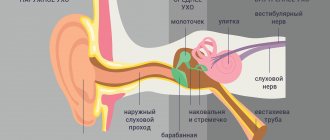A dry cough can be a symptom of many pathological conditions in the body, ranging from a mild cold to very serious diseases. If it occurs, you need to consult a doctor for a diagnosis.
Author:
- Galkin Alexey Vladimirovich
ENT pathology expert
3.33 (Votes: 15)
Coughing is a natural protective reflex of the body, a contraction of the chest muscles in response to the action of any irritant. Normally, it helps cleanse the mucous membranes of the respiratory tract from dust, mucus, and harmful microorganisms.
There are two types of cough: wet (productive) and dry (non-productive). In the first case, sputum is discharged, and the cough ultimately brings relief to the person. In the second, the cough is prolonged and painful, without sputum production, and is perceived by the person as much more painful. Most often, the disease begins with a dry cough, after which it transforms into a wet one, but sometimes this does not happen. A dry cough can be a symptom of many pathological conditions in the body - from a mild cold to serious illnesses. When it appears, even without signs of a cold or any other manifestations, you need to consult a doctor for a diagnosis. This will guarantee quick relief from dry cough, identification of the underlying disease or indication for lifestyle correction.
What is a dry cough?
Depending on its specifics, it can be:
- Long lasting. Usually it doesn't take at least a few minutes.
- Paroxysmal. Accompanied by difficulty breathing, severe wheezing, and a feeling of tightness in the chest.
- "Barking." So named due to its resemblance to the sounds made by animals.
- Suffocating. Accompanied by the inability to breathe air, usually for a few seconds. This is the most dangerous condition that requires urgent help.
- At night. Makes you wake up and doesn't go away for several minutes. Attacks of suffocation may occur.
This classification is needed so that you can describe your symptoms to the doctor in detail. It is important to talk about the time of occurrence of attacks, their duration, pain or absence thereof, impact on adjacent parts of the body, and other details.
Why does ARVI selectively affect people?
Having been chilled outside, we try to warm up at home with hot tea and take a bath, but, unfortunately, these simple but effective procedures do not help everyone. This fact is explained by the general health of a particular person. Hypothermia of the body only triggers the mechanism of a cold, but the nature of the further development of the disease is determined by other reasons.
- A hypothermic body is easily affected by respiratory viruses, including the influenza virus. Entering into a favorable environment, pathogenic microflora begins to actively multiply.
- Susceptibility to infection is largely determined by the state of the immune system. For example, chronic diseases significantly weaken the body’s ability to fight viruses and bacteria that have entered it.
- Patients with enlarged tonsils or with constantly inflamed sinus mucosa are much more likely to be exposed to ARVI. Hypothermia will cause an exacerbation of chronic diseases in them.
- The state of the gastrointestinal tract also affects the level of immunity. The likelihood of catching a cold increases significantly with dysbiosis caused by taking antibiotics or internal causes.
- It is no secret that the likelihood of contracting ARVI increases when a person is in a stressful situation and experiences strong psycho-emotional stress.
The body's reaction to the active activity of pathogenic microflora will also be different.
What diseases can cause cough?
A dry cough can be a consequence of:
- Inflammation of the larynx. At the same time, the sound is “barking”, the voice becomes hoarse, and the attacks themselves more often occur at night.
- Inflammation of the trachea and bronchi. A dry cough lasts 2-3 days, after which it turns into a wet cough and sputum begins to be released.
- Tuberculosis. A cough with tuberculosis does not end for several weeks in a row, despite taking any medications. The cough characteristic of this disease is frequent, dry and hacking, intensifying over time, accompanied by wheezing and sputum, and may be accompanied by hemoptysis.
- Pneumonia. At first it is “barking” and dry; from the 2-3rd day of the disease, sputum begins to be released, sometimes mixed with blood.
- Bronchial asthma. The cough is painful, with attacks of suffocation. The condition is dangerous, as with any attack of suffocation.
- Malignant tumors in the respiratory system. In oncology, the cough may be mild, depending on the type of tumor and its size. Shortness of breath is typical, chest pain and coughing up blood are possible. Any cancer is accompanied by weight loss and weakness.
- Whooping cough. The cough is severe and paroxysmal, often ending in vomiting. It is not blocked by any dry cough medications and can last for several months.
- Corey. Associated symptoms are fever and skin rash.
- Entry of foreign bodies into the respiratory tract. In this case, emergency medical care is important, as the condition can cause suffocation.
- Allergies. An allergic dry cough occurs directly upon contact with an allergen - dust, pollen, gases, chemicals, household chemicals. It can develop in industrial workers through inhalation of dust and small particles. This condition is usually accompanied by an allergic runny nose without other signs of a cold. If there is no exposure to the allergen, it stops.
- Smoking. “Smoker's cough” usually appears in the morning; it can be long-lasting, dry, with poorly separated sputum.
- Pleurisy. The cough is very painful, to the point that it is difficult for a person to change body position and gives off severe pain in the chest. Fever, chills, shortness of breath, and weakness appear.
What you need to know about cough?
Any cough is not a pathology in itself, it is a consequence of certain disorders in the body. By nature, it is conceived as a kind of protective mechanism. When irritants or foreign bodies (including microscopic ones) enter the respiratory system, receptors begin to react, muscles contract, and we cough. In this way, the body tries to cleanse itself, and if it manages to do this on its own, there is no need for additional treatment.
With a rare, isolated cough, there is really no need to worry. Perhaps there is a lot of dust accumulated in the room or you have become hypothermic outside. But when it lasts more than seven days, even if there is no fever or other signs of illness, it is always a sign of illness. In this case, you should not limit yourself to traditional methods of getting rid of cough and delay going to the doctor. By eliminating a symptom, you do not solve the problem itself, and this is what is most important.
Diagnosis and treatment
To identify the root cause, your doctor may order the following tests:
- X-ray;
- fluorography;
- bronchoscopy;
- auscultation;
- percussion;
- blood tests for allergens.
The main goal of treating a dry cough is to transform it into a wet cough - productive with sputum discharge. Treatment is complex, using medications, physiotherapy, and in some cases traditional medicine.
Drug therapy includes: antiviral, antitussive, antihistamine, mucolytic agents, antibiotics. It is important to know that taking antitussive drugs without a doctor’s instructions is strictly prohibited - this can cause the accumulation of mucus in the respiratory tract and lead to stagnation of mucus in the lungs, and this will lead to serious complications.
Physiotherapeutic procedures include:
- warming up;
- inhalation;
- UHF;
- acupuncture;
- electrophoresis.
Treatment of cough without fever
The list of causes of cough without fever can be continued endlessly, because each individual case is always individual. To make an accurate diagnosis, you should consult a doctor. In this case, you can start treatment for cough without fever in time and avoid complications. It should be noted that complex therapy is often prescribed, because this ailment is usually a consequence of a more serious disease. Drugs that are used to treat cough without fever can be grouped into the following groups:
- antitussives,
- expectorants,
- antihistamines.
In addition, you can use inhalations with medicinal substances and solutions. When coughing without fever, they help moisturize the mucous membrane, reduce swelling of the airways and get rid of phlegm. Among the general recommendations, humidification of the room where the patient is located, walks in the fresh air, and plenty of warm drinks are often noted.
Sources
The following materials were used to create this article:
- G. A. Samsygina. Cough in children. Clinical manual - 2nd ed., revised. and additional - Moscow: GEOTAR-Media, 2021. - 192 p.: ill. — (Series “Library of a Medical Specialist”).
- Glukhov S.A. Artificial cough // Great Medical Encyclopedia: in 30 volumes / ch. ed. B.V. Petrovsky. — 3rd ed. - M.: Soviet Encyclopedia, 1979. - T. 10: Kabakov - Coalescence. — 528 p.: ill.
- I. G. Bereznyakov. Mechanisms of cough // News of medicine and pharmacy, December 2005, No. 20-22 (180-182).
- Nikitin V. A., Marks S. I., Tolstykh E. M., Vasilyeva L. V. Clinical variants of the cough reflex and their correction / Voronezh State Medical University named after N. N. Burdenko. // M.: Russian Respiratory Society (RRO), 2021. Scientific and practical journal “Pulmonology”, No. 26 (2).
2. Reasons
The main causes of nonproductive cough include:
- irritation of the respiratory tract by chemical and/or physical factors (toxic substances, aggressive fumes, active or passive smoking, dusty air, thermal effects, etc.);
- foreign bodies;
- mechanical pressure on the airways from the aortic aneurysm, growing tumor, enlarged lymph nodes;
- chronic obstructive pulmonary disease (COPD);
- fibrosing processes (proliferation of scar-connective tissue);
- bronchial asthma;
- respiratory infections (including pulmonary tuberculosis);
- allergic reactions;
- diseases of the esophagus and stomach, occurring with reflux syndrome;
- occupational pneumoconiosis;
- cardiovascular diseases (for example, left ventricular failure);
- long-term use of ACE inhibitors (angiotensin-converting enzyme);
- diseases of the central nervous system (damage to a special “cough” center in the medulla oblongata causes the so-called cough of central origin);
- thyroid diseases;
- high altitude hypoxia.
In many cases, a dry cough is caused not by one reason, but by two, three or more.
Visit our Pulmonology page
Why do cold symptoms vary from person to person?
The manifestations of the disease depend on the combination of the above factors. As a rule, a person may initially have a sore throat, a runny nose and a fever. Most patients consider only a rise in temperature to be a more or less serious symptom, and in its absence, sore throat, runny nose and even cough are ready to endure on their feet. The idea that bronchitis and even pneumonia may be hidden behind a cough occurs to the average patient only at elevated temperatures. Why doesn’t the immune system respond by increasing it in all cases?
- The severity of the reaction is determined by the type of pathogen that has entered the body. Thus, the body almost always reacts to infection by strains of influenza and some other aggressive viruses with an elevated temperature.
- An increase in temperature means that the immune system has begun to do its job, producing antibodies. But in some patients with weakened immunity, an immune response is not formed, and there is no fever during ARVI. This may mean that the body is infected with a rather dangerous virus that it is not able to fight on its own.
- Modern “anti-cold” pharmaceutical drugs based on paracetamol, which people with colds like to prescribe to themselves, quickly relieve cold symptoms, especially quickly coping with elevated temperatures. But they do not destroy pathogenic viruses and do not strengthen the immune system, which means they do not help the body overcome ARVI.
Survey
Since in most cases the presence of a superficial cough indicates damage to the upper respiratory tract, at the first stage of the diagnostic search the condition of the nasal cavity, pharynx, and larynx is clarified, and only after that other possible causes are excluded. The organization of the examination is usually carried out by an ENT doctor, who, according to indications, prescribes consultations with specialized specialists. The following are recommended as screening tests:
- Instrumental inspection methods
. During rhinoscopy, pharyngoscopy and laryngoscopy, the condition of the mucous membrane of the upper respiratory tract is assessed. The examination reveals inflammatory processes, erosive changes, and space-occupying formations. - Microbiological and serological studies
. To search for pathogens, culture of swabs from the nose, pharynx and laryngeal mucosa is used. Effective ways to confirm the infectious nature of a cough and identify the pathogen are ELISA, RIF, and PCR.
At the next stages of diagnosis, contrast radiography of the esophagus and esophagoscopy are performed to exclude Zenker's diverticulum. If a superficial cough is suspected to be of allergic origin, allergy tests are prescribed. An informative method for diagnosing malignant tumors of the thyroid gland is ultrasound of the organ. In the absence of organic causes of coughing, a neurological examination is recommended.
Instrumental examination of the upper respiratory tract
Diagnosis of dry cough
A severe dry cough in an adult is a reason to visit a doctor. You can start with a therapist, and if necessary, he will refer you for consultation to specialists of a narrow profile. An initial examination is necessary to assess the condition of the respiratory system, so the doctor may prescribe diagnostic methods such as:
- plain radiography of the chest organs;
- tuberculosis test;
- general blood test with leukocyte formula;
- bronchography or bronchoscopy;
- spirometry;
- Ultrasound of the pleura - the membrane covering the lungs;
- CT scan of the chest;
- allergy tests, etc.
General information
Cough is a protective mechanism of the respiratory system in response to irritants or sudden changes in the environment. Often, although not an independent pathology, a cough signals a disruption in the functioning of the body. In case of rare coughing attacks without fever in children, there is no need to worry: this is a one-time reaction to irritating particles (for example, dust), smoke or saliva entering the upper respiratory tract. It is normal to cough as a reaction to a sharp change in temperature when inhaling cold air. A cough lasting more than a week is a cause for concern. In the absence of fever and other alarming symptoms, a prolonged cough is always a sign of pathology. Often in children, a cough without fever indicates the development of an allergic reaction. A prolonged cough without fever requires diagnosis, observation and treatment by a specialist: pediatrician, otolaryngologist, allergist. Dangerous complications include bronchial asthma.








